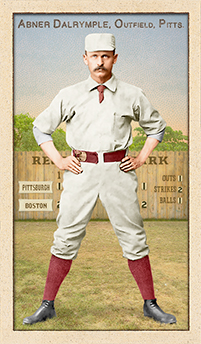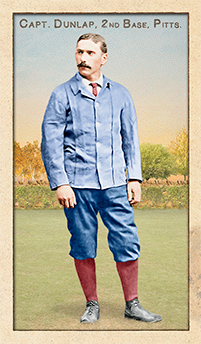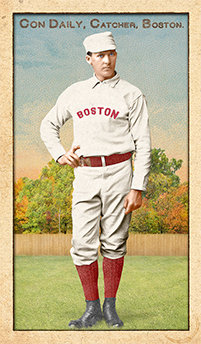
- Series: Beginnings: 1880's
- City: Boston
- Team: Beaneaters
- League: National League
Cornelius F. Daily (1864-1928) was a veteran of 13 ML seasons as a reliable and beloved catcher for some of the most colorful teams of his day. He caught Old Hoss Radbourn with the Providence Grays and moved with his battery mate to the Beaneaters in 1886. Later, Con was a favorite of John Montgomery Ward, playing for Ward’s Wonders in Brooklyn in the short-lived Players’ League and accompanied Ward when the new NL Brooklyn franchise beckoned. The Brooklyn Eagle recounted numerous stories of Daily’s exploits that endeared him to the home folks. Club president Charles Byrne said of Con “He is quite an all around player, a hard batter and a fine base runner.” Indeed, Daily is still regarded as the fleetest of foot at his position in Dodger franchise history, having been credited with 94 career steals (albeit in a very different era than today).
- In ’95 Daily survived a near-fatal accident diving into the surf at Sheepshead Bay. The local paper noted that he had saved a girl from drowning near the same spot only weeks earlier
- Daily’s ML tenure ended in 1896 with a brief stint with Cap Anson’s Chicago club
- Series: Beginnings: 1880's
- City: Philadelphia
- Team: Quakers
- League: National League
Edward M. Daily (1862-1891) broke in with a bang for the Quakers in 1885, winning 26 games, 5th in the NL. He played mostly in the outfield for a few years and teams before returning to the mound in 1890 as the “star” pitcher for the Brooklyn Gladiators’ only year in the AA, going 10-15 for the last place club. With Ward’s Wonders of the Players’ League and the NL’s Bridegrooms, Daily was part of a three-team Brooklyn entry that one year.
- Got to play in the “world series” in 1890 for Louisville, Daily’s third team that frantic year
- Died following his stint with the Washington Statesmen in their final year in the AA
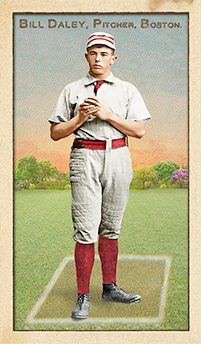
- Series: Beginnings: 1880's
- City: Boston
- Team: Beaneaters
- League: National League
William Daily (1868-1922) was a pitcher who had the rare opportunity of playing for two pennant winners, back-to-back, in two leagues. The only other team to do this was Brooklyn just prior to Daily’s Boston Reds/Beaneaters staging their coup in 1890/91. Daily had broken into pro-ball with the Jersey City Skeeters in 1887 as a 19-year-old. He came up with the NL’s second-place Beaneaters in 1889, getting into nine games and going 3-3. He stayed with most of his mates when they ventured into the Players’ League the following year and Ed excelled with an 18-7 record good for the league lead in winning percentage although Old Hoss Radbourn and Ad Gumbert won more for King Kelly’s Reds that championship season. Daily’s productivity dropped dramatically as the club joined the American Association in ’91, giving the young pitcher the chance to play in three leagues in consecutive seasons. After an 8-6 record, Bill returned to Buffalo/Albany through 1893.
- The Bridegrooms had performed their back-to-back feat in 1889-90 with the AA and the NL
- Series: Beginnings: 1880's
- City: Pittsburgh
- Team: Alleghenys
- League: National League
Abner Dalrymple (1857-1939) was one of the most prolific hitters of the fledgling NL. He was the leadoff batter for 8 straight years (with 5 pennants) for the Chicago White Stockings, contributing to a team home run record in 1884 that stood until eclipsed by the ’27 Bronx Bombers. He hit over .300 six times.
- Still shares a record for 4 doubles in 4 at-bats, July 3, 1883
- A.G. Spalding paid $2500 (!) to get Dalrymple from the Milwaukee Grays in 1878
- Dalrymple earned that confidence, winning the NL batting title in his rookie year
- In 1881 became first ever batter to be intentionally walked with bases loaded
- Dalrymple's uniform color in this card was changed from blue to red in August, 2017 to reflect recent reliable research conducted by Craig Brown and friends at Threads of Our Game. Two cards were previously released featuring a blue uniform

- Series: Beginnings: 1880's
- City: Chicago
- Team: White Stockings
- League: National League
Thomas Peter Daly (1866-1938) began his fine 16-year career as a catcher/second-baseman with the Chicago White Stockings in 1887 but was a mainstay with Brooklyn for 11 seasons, 1890-1901. Slightly-built and swift, “Tido” stole 385 bases, enabled by his .278 lifetime average that got him on base a lot for a catcher (he hit .294 in Brooklyn.) By the mid-nineties he had transitioned to the infield. Daly played for three pennant-winners in 1890, 1899 and 1900, all in Brooklyn. He is reported to have hit the first pinch-hit home-run in history on May 14, 1892 off John Clarkson. Tido was a “lifer” who stayed around the game in the minors as a player/manager and scout. He last played for the Johnstown Johnnies in 1907 and even managed for Toronto in 1932 at age 66.
- In 1891 Daly caught Tom Lovett’s no-hitter against the Giants
- Daly's uniform color in this card was changed from black to blue in March, 2017 to reflect recent reliable research conducted by Craig Brown and friends at Threads of Our Game. Four cards had been previously released featuring a black uniform.
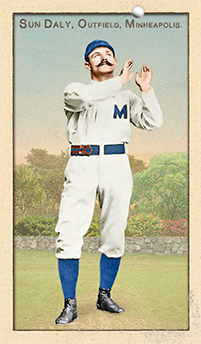
- Series: Beginnings: 1880's
- City: Minneapolis
- Team: Millers
- League: Western Association
James J. Daly (1865-1938) compiled a very short major league slash line. Sun made it to the big leagues with the Baltimore Orioles in 1892, joining one of the more ferocious teams of the era. He got into a mere 13 games and went 12-48 for a .250 average with seven RBI for the last-place team. With the likes of McGraw, Hanlon, Stovey and Wilbert Robinson - this was a down year for a team on the cusp of greatness. Already the squad was known for making its own rules and playing with a snarl. Thus, it was unlikely for a new kid to make the big club and Daly soon found himself back in the minors. He had begun playing ball in his hometown of Port Henry, NY and moved into the professional ranks with Portsmouth of the New England League in 1888. The next year he was out west with two Twin Cities clubs where he was photographed by the Old Judge crew. The Goodwin editors note that Daly was the poorest-fielding left fielder in the Western Association at that time. He returned east with Portland and Lebanon in '91 and began the '92 campaign with the Buffalo Bisons of the Eastern League. It is said that Daly acquired his nickname in the Buffalo outfield as he played the position while eschewing sun glasses. His distinctive moniker not enough to gain a toe-hold with the Orioles, Sun shuffled back to Buffalo for the '93-94 seasons. Daly then moved to Rochester for two years before wrapping it up in 1897 with stints for three Pennsylvania franchises: Reading, Scranton and Wilkes-Barre.
- Sun's best year at the plate was 1895 with Rochester where he hit .337 in 128 games, by far his most prolific season
- While his endurance at the pinnacle of his sport was short-lived, Daly set a much finer life-mark by living just long enough to celebrate fifty years of marriage to the mother of their four children
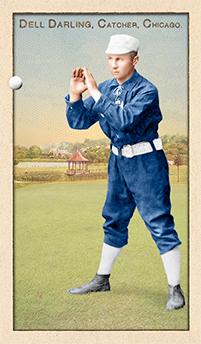
- Series: Beginnings: 1880's
- City: Chicago
- Team: White Stockings
- League: National League
Conrad Darling (1861-1904) was a modest-hitting journeyman catcher knocking around the hard-scrabble baseball towns of western Pennsylvania when The Sporting Life took note of his work following the 1886 season: “Darling was undoubtedly the most valuable man behind the bat in the International League.” Suddenly, Dell was in demand, spurning an offer from Jim Mutrie’s Giants and signing with Cap Anson’s Colts. He played well but sporadically until trying his fortune with Comiskey’s Chicago Pirates in the 1890 Players’ League. His career was in steep decline, likely due to the usual toll of catching in the big leagues. Dell played only part time for the Browns in ‘91 before hanging ‘em up. He did gain a short bit of notoriety by being implicated in a massive scheme to rob moving trains. He and other ballplayers were accused of pilfering baggage and tossing the spoils to confederates trackside. The publicity faded shortly with no indictment.
- The origin of Darling’s nickname is unknown but stayed with him through his obituary
- It was speculated that an old baseball injury contributed to Dell’s early demise
- Darling's uniform color in this card was changed from black to blue in March, 2017 to reflect recent reliable research conducted by Craig Brown and friends at Threads of Our Game. One card had been previously released featuring a black uniform.
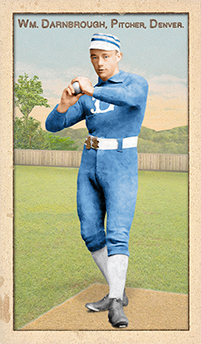
- Series: Beginnings: 1880's
- City: Denver
- Team: Grizzlies
- League: Western Association
William Darnbrough is another of the minor leaguers featured by Old Judge. They published 2 poses of this right-handed hurler in 1889 while he was with the Denver Grizzlies of the WA. Baseball-reference.com researchers have compiled a bare-bones profile of this player’s work for the Bloomington Reds of the Central Interstate League, Aurora of the Illinois-Iowa League, the Western League’s Kansas City Blues and Lincoln Rustlers and Darnbrough’s final assignment with the Rochester Flour Cities of the Eastern League. Most of the data is very sketchy, given the state of minor league ball in the 19th century. The year he met the Old Judge folks, Darnbrough had a busy year with a 12-14 record and a 4.37 ERA in 32 games. He got into 41 games as a batter with a .232 average. His play was more limited thereafter, but he closed his tenure in pro ball with a hefty .333 average for the Flour City lads (playing in only 6 games in their ’92 season).
- Darnbrough and his teammates were party to a blue law suit in Lancaster County, NE in 1891 – charged with unlawful play on Sunday, April 26 (before 3,000 similarly renegade fans)
- The case seems to have been brought to expose and overturn such prohibitions. The Nebraska Supreme Court eventually upheld the ban on Sunday play, a decision that would stand in the state until 1913
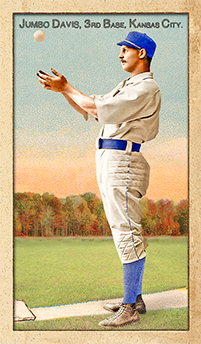
- Series: Beginnings: 1880's
- City: Kansas City
- Team: Cowboys
- League: American Association
James J. Davis (1861-1921) played 3rd base during 7 seasons for 6 major league teams (twice with Kansas City in different incarnations). He broke in with KC’s Cowboys of the Union Association in 1884 and later played for their American Association contingent in ’88-89. He also played for the Gladiators, Brooklyn’s Players’ League entry in 1890, finishing his time in the big leagues for the Washington Statesmen during their final year in the AA, 1891. “Jumbo” was a sturdy 5’11” and 195 lbs, hardly a giant but he must have impressed with his strength, leading the league in triples in ‘87 and generally hitting for a respectable average. His career BA was .272 with 468 hits in 453 games. The native New Yorker had begun minor league ball in 1883 with the Quincy, IL, Quincies in the Northwestern League (when Indiana, Illinois and Michigan were considered the “northwest”).
- In 1888, Davis saved a girl from drowning at the Coney Island shore while the Cowboys were on a road trip to NY
- Following his final game in D.C. “Big Jim” umpired some AA contests in 1891
- Also played for the Orioles and Browns, finding his post-retirement home in St. Louis
- Series: Beginnings: 1880's
- City: New York
- Team: Giants
- League: National League
Thomas H. Deasley (1857-1943) was a catcher for eight years for four ML clubs: the Boston Red Caps, St Louis Browns, NY Giants and Washington Statesmen from 1881 through ’88. This Irish immigrant compiled a .244 BA and did not hit a home run in the “Dead Ball” era.
- Pat’s best year was 1887 with the Giants, hitting .314 with a .367 OBP
- That NY team was noted for being nearly all Irish: Mike Dorgan, Pete Gillespie and Jim O’Rourke were the OF, while all but 2 innings in ’85 were pitched by Irishmen for example

- Series: Beginnings: 1880's
- City: Philadelphia
- Team: Quakers
- League: National League
Earle Harry Decker (1864-?) was a catcher for six teams over four seasons in the majors. He came into pro ball at an opportune time for a young man. 1884 saw the arrival of the short-lived Union Association whose entry into the “big leagues” allowed many minor league and marginal players a chance at the elite level, if only briefly. Harry was nothing if not opportunistic. He was clever enough to patent a thumbless catcher’s mitt (“The Decker Safety Catcher’s Mitt”) and cunning enough to pursue a criminal career that landed him in San Quentin prison under the name Earl Henry Davenport. Harry led a long life of crime, using multiple aliases, which has prevented baseball historians from tracking his life after baseball. He did show up in a team photo of the San Quentin squad and a reporter recalled him from his Keokuk days as a good defensive catcher. A versatile fielder, Decker played most positions but was a weak hitter, resulting in short stints in the majors followed by return to the minors (five teams in the US and Canada.)
- Harry’s most productive season was his last, with Pittsburgh, in 1890. He hit .274 in 92 games
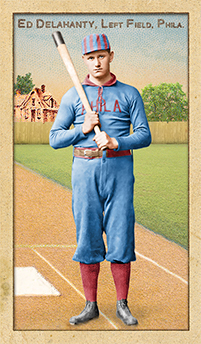
- Series: Beginnings: 1880's
- City: Philadelphia
- Team: Quakers
- League: National League
- Hall: National Baseball Hall of Fame
Edward James Delahanty (1867-1903) died in the icy waters of the Niagara River while still in his baseball prime. He was hitting .333 for the Senators that July of 1903, well below his days with the Phillies, but still a force to be reckoned with after a 16-year career in left field. Through the 1890s no hitter dominated as did Big Ed. With Sam Thompson and Billy Hamilton he formed an outfield-for-the-ages, each hitting .400+ in 1894. He struggled during his early years until, driven to excel, Ed transformed himself at the plate. Personal achievement had not brought a pennant, however, and Delahanty experienced the frustrations of the reserve system in his pursuit of the pay he felt was his due. As with so many players of that day, Ed turned to the bottle and was given to outbursts such as the one that got him ejected from the train the night he died. His tragic end came amid one of the great careers in baseball history.
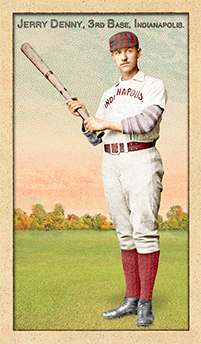
- Series: Beginnings: 1880's
- City: Indianapolis
- Team: Hoosiers (NL)
- League: National League
Jeremiah Dennis Denny (1859-1927) was a rare ambidextrous third baseman who played professionally for over 20 years, 13 in the majors. He was the last position player to play his entire career without a glove, which would have hindered his ability to use his left hand when the play required. Denny broke in with the Providence Grays and led them to the first inter-league post-season tournament championship as the NL beat the AA in 1884. Jerry teamed with Arthur Irwin at short to create a formidable combination on the left side. He won the first-ever “series” game with a three-run homer off Tim Keefe of the Metropolitans. Providence closed down and Jerry moved to the Maroons in St. Louis for a year and then on to Indianapolis when the team relocated. A reliable batter with good power, Denny compiled a .260 career average and 74 HRs.
- Holds the MLB record for chances by a third baseman in a game: 16 on 8/17/82
- Denny was a pseudonym, adopted while in college in Phoenix to mask his semi-pro forays that were barred to amateurs. His birth name was Eldridge

- Series: Beginnings: 1880's
- City: St. Louis
- Team: Browns (AA)
- League: American Association
James H. Devlin (1866-1900) was another of those Troy, NY (Lansingburgh) ballplayers to make an impact on the major leagues in the 19th century. The game was growing into a national pastime and Troy was at its center in the post-Civil War years when Devlin was born. He began with Syracuse of the International League in the spring of 1886, going 2-4 with a 1.05 ERA, which earned him a call-up to the NL's Giants that summer. He would continue to shuttle between major and minor league clubs for the next decade. His time in the big leagues included two more teams, the Philadelphia Quakers and the St. Louis Browns, then of the American Association. After the 1889 season in St. Louis, Devlin was out of baseball for a year before leading the Eastern League's Albany Senators with 26 wins in 40 decisions in '91. His MLB record was a mere 11-10, but he compiled a very respectable 3.38 ERA. Like so many before and since, Devlin fared much better in the minors. Jim would play in the Eastern and Pennsylvania Leagues through the mid-'90s and closed his professional career in the Canadian League, going 2-0 for London despite surrendering 14 runs. Every pitcher would pray for such support.
- All together Devlin won 106 games in the minors, including 21 with his hometown Troy Trojans
- Among many major leaguers to perish at too young an age, Devlin succumbed to typhoid fever at 34 back in Troy
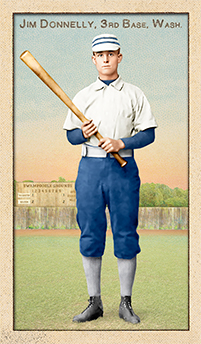
- Series: Beginnings: 1880's
- City: Washington, D.C.
- Team: Nationals
- League: National League
James B. Donnelly (1865-1915) had eleven seasons in the majors, playing third base for nine teams. While he toiled in relative obscurity for most of his career, Donnelly had the thrill, in its waning days, of being part of a remarkable championship season with the Orioles in 1896. In that storied year, the club walked away with its third straight NL pennant, besting second-place Cleveland to win the Temple Cup in the post-season. Donnelly had, by far, his greatest offensive production in ‘96, hitting .328 - over a hundred points above his lifetime average. That effort would have been a headliner for any other team, but in Baltimore Donnelly was only the sixth-best on the squad. Jim was overshadowed by pretty good men: Wilbert Robinson .347, Jack Doyle .339, Hughie Jennings .401, Willie Keeler .386, and Joe Kelley .364. Talk about Murderers Row! The Ned Hanlon/John McGraw powerhouse was soon to disband as the NL went from twelve to eight teams to accommodate the new American League a few years later.

- Series: Beginnings: 1880's
- City: Omaha
- Team: Omahogs
- League: Western Association
John S. Doran played for 6 minor league teams over 5 years. He was with the Quincy, IL, Quincies club of the Northwestern Association in 1883 and then shows up on the Eau Claire Lumbermen and Oshkosh teams in the same league in ’86 and ’87. At Oshkosh, Doran played for future Hall of Fame manager Frank Selee who went on to the majors in 1890. The following year Jack played for the Davenport Onion Weeders and the Omaha Omahogs of the Western Association. His final year was with Worcester of the Atlantic Association. Based on the limited documentation available, Doran’s finest year was with Selee’s squad where he hit .334 in 504 ABs and stole 18 bases.
- Doran got into 25 games for the ’88 Omahogs
- Based on the year he had in Oshkosh, it is curious that Selee didn’t take Jack to the Beaneaters
- Although the Old Judge series features two known poses of John Doran, I could not find one of suitable quality for this project. This image is taken from an Old Judge proof taken at the same time as Doran's other OJ images and may represent an as-of-yet undiscovered pose.
- Series: Beginnings: 1880's
- City: New York
- Team: Giants
- League: National League
Michael Cornelius Dorgan (1853-1909) was an outstanding hitter and fielder whose career (and life) was cut short by numerous injuries due to his aggressive play. He starred for the St. Louis Brown Stockings and ended with the Syracuse Stars, his hometown team. Surgery on his knee, hurt making a game-saving catch in 1887, led to blood poisoning and his premature death.
- First Syracuse resident to play in the NL
- Awarded the New York Clipper Gold Badge Award as top defensive player at his position
- Managed parts of 3 seasons for 3 different NL teams from 1879-1881
- Elected to Syracuse Hall of Fame: 1999
- Series: Beginnings: 1880's
- City: St. Louis
- Team: Browns (AA)
- League: American Association
Charles Edward Duffee (1866-1894) was an outfielder for four clubs from 1889 through 1893, beginning with the St Louis Browns for two seasons, then playing during one year each for the Columbus Solons, Washington Senators and Cincinnati Reds. That last assignment was very short-lived, as Duffee played only four games in April, 1893.
- Duffee’s career BA was .267 with 35 HRs and 33 triples
- “Home Run” Duffee hit 16 in his rookie season, third in the AA
- Duffee’s career was cut short by ill health, and he died of “consumption” Christmas Eve, 1894
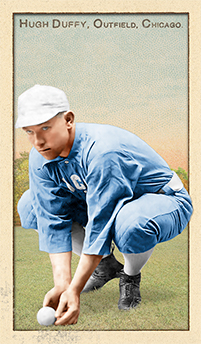
- Series: Beginnings: 1880's
- City: Chicago
- Team: White Stockings
- League: National League
- Hall: National Baseball Hall of Fame
Hugh Duffy (1866-1954) is as much a baseball institution as the Hall of Fame that enshrines him. For 68 years he devoted himself to the game he loved and excelled at as few ever have. In 1894 he set the all-time mark with a .440 average while winning the triple crown. He made HOF pitchers look like batting practice coaches: .586 against John Clarkson, .650 vs Cy Young. Amos Rusie was the exception, holding Duffy to a mere .333. So diminutive Cap Anson nearly dismissed him (“We already have a bat boy”), Hugh hustled his way to becoming the only player to hit .300 in four leagues and let the power follow his form (“hit ‘em up the middle”) winning two HR titles. Duffy went on to coach, manage, scout and mentor for a half-century after hanging up his spikes. He was still hitting fungoes eight years after his induction into Cooperstown and delighted in pupil Ted Williams’ success as he sought in vain to eclipse Duffy’s record in 1941.
- Playing career spanned 19 years, primarily in Chicago, Boston and Philadelphia
- Played center field for the Beaneaters next to his “Heavenly Twin,” Tommy McCarthy in right, leading Boston to a pair of pennants
- Elected to Hall of Fame: 1945
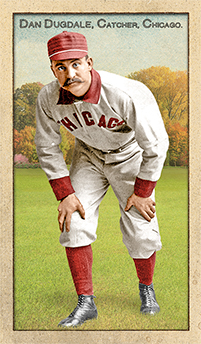
- Series: Beginnings: 1880's
- City: Chicago
- Team: Maroons
- League: Western Association
Daniel Edward Dugdale (1864-1934) had a brief exposure to major league baseball but carried the game’s torch to Seattle where he dominated the Pacific Northwest sports scene for 36 years until his sudden death crossing the street in front of a truck the night before his annual banquet celebrating the game. Big “Dug” had been a savvy catcher for the KC Cowboys and Washington Senators before migrating west seeking Klondike gold. He settled in Seattle where his devotion to baseball and his entrepreneurial instincts melded into a different kind of gold. He founded and managed teams, he built the first double-deck stadium on the coast, he was a warrior fending off the Pacific Coast League invaders from California. At last, he settled for being a legend in Rainier’s shadow, extolled at the banquet he missed as the Northwest’s “greatest individual figure in the national game.”
- When he decided to stop being the backup to Deacon McGuire in D.C., Dug went home to Peoria and founded the Distillers in what was then the world’s spirits capital
- Dugdale Park endured for decades until it perished two years before its owner, victim to a serial arsonist with an oil drum in the heart of the all-wood structure
- Series: Beginnings: 1880's
- City: Pittsburgh
- Team: Alleghenys
- League: National League
Frederick C. Dunlap (1859-1902) strode the heights of baseball throughout the 1880s as the “king of second basemen.” Highest-paid, adored by fans, sought by clubs who needed to win, the slick-fielding, sharp-eyed batsman could write his own ticket, and did. When Detroit (which had paid a record price to secure him from St. Louis) wanted to sell him to Pittsburgh, “Sure-Shot” demanded and nearly got half the proceeds. Despite never using a glove, this graceful fielder consistently ranked as the best at his position. In 1910, the founder of The Sporting News said he had seen them all and Dunlap was “the greatest that ever lived.” Yet his fall equaled his rise: forced out by a broken leg, a decade later his fortune was gone, as were his friends and health. “King Fred” died in 1902 “clean broke” without enough to carry his coffin.
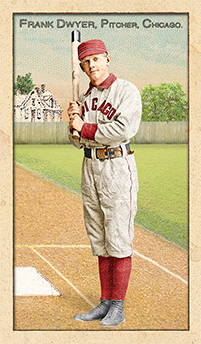
- Series: Beginnings: 1880's
- City: Chicago
- Team: Maroons
- League: Western Association
John Francis Dwyer (1868-1943) served MLB as player, manager and umpire. He won 176 games, led the NL in saves in 1893, piloted the ’02 Tigers and officiated Cy Young’s perfect game on May 5, 1904. The Massachusetts native was college-trained when he began his big league career in 1888 with Chicago’s White Stockings. Over his twelve year playing span, the right-hander completed 270 of his 318 starts. Dwyer’s hitting was good enough that he played four other positions, hit five HRs and compiled a .229 BA.
- Dwyer won over 15 games in nine of his twelve years including two 20+ seasons
- Dwyer was the workhorse on Kelly’s Killers (aka Cincinnati Porkers) during their 1891 AA season-still perhaps the rowdiest bunch in a wild era when franchises and whole leagues were forming and folding with abandon. Player-manager Mike “King” Kelly and owner Chris von der Ahe shared the conviction that beer and baseball were made for each other. That Dwyer could win 13 games under their leadership is a tribute to his athletic prowess.



